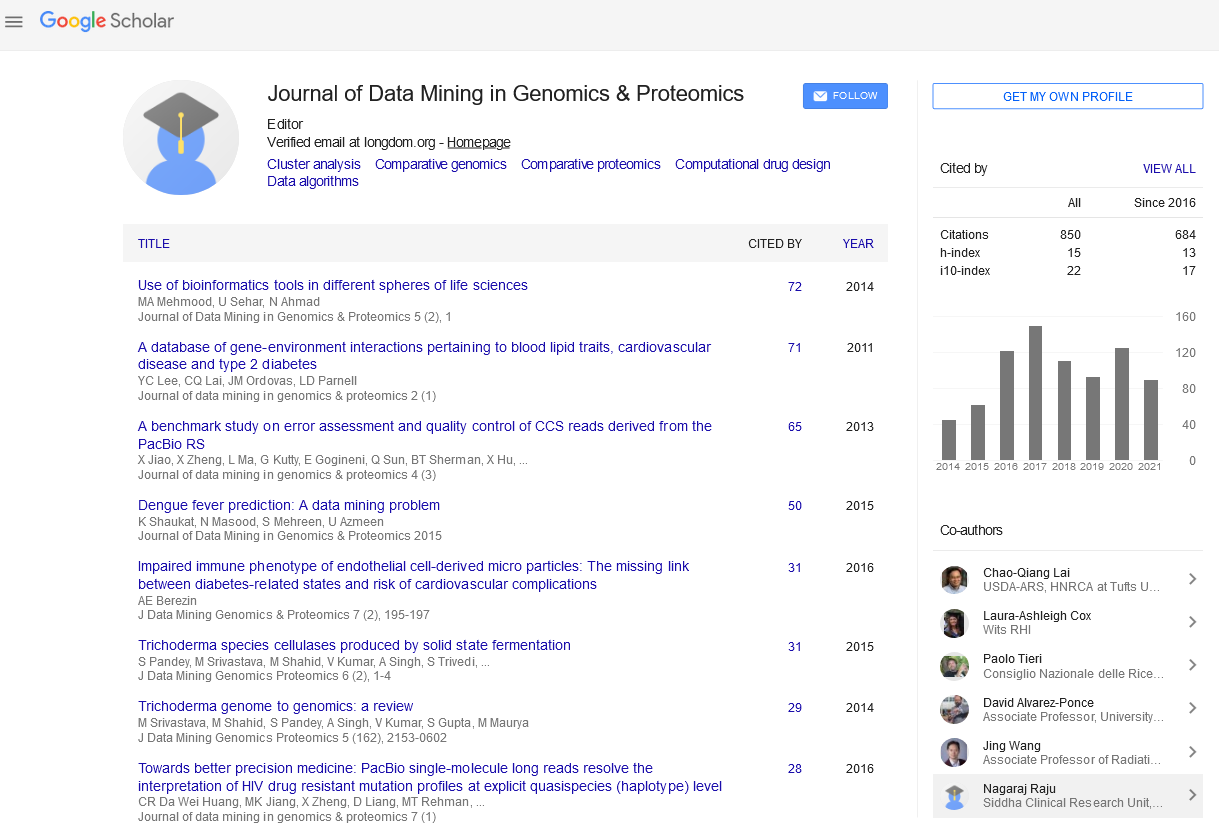PMC/PubMed Indexed Articles
Indexed In
- Academic Journals Database
- Open J Gate
- Genamics JournalSeek
- JournalTOCs
- ResearchBible
- Ulrich's Periodicals Directory
- Electronic Journals Library
- RefSeek
- Hamdard University
- EBSCO A-Z
- OCLC- WorldCat
- Scholarsteer
- SWB online catalog
- Virtual Library of Biology (vifabio)
- Publons
- MIAR
- Geneva Foundation for Medical Education and Research
- Euro Pub
- Google Scholar
Useful Links
Share This Page
Journal Flyer

Open Access Journals
- Agri and Aquaculture
- Biochemistry
- Bioinformatics & Systems Biology
- Business & Management
- Chemistry
- Clinical Sciences
- Engineering
- Food & Nutrition
- General Science
- Genetics & Molecular Biology
- Immunology & Microbiology
- Medical Sciences
- Neuroscience & Psychology
- Nursing & Health Care
- Pharmaceutical Sciences
microRNA as blood-based biomarkers
2nd International Conference on Big Data Analysis and Data Mining
November 30-December 01, 2015 San Antonio, USA
B. Nelson Chau
Regulus Therapeutics Inc., USA
Posters-Accepted Abstracts: J Data Mining Genomics Proteomics
Abstract:
MicroRNAs (miRNAs) are ~23 nucleotide long non-coding RNAs that regulate various biological processes through interacting with mRNAs. In many disease states, miRNA expression is dysregulated and the aberrant signatures have been used as diagnostic and prognostic biomarkers. miRNome is less complex (i.e. ~1,000 miRs encoded in human genome) and are expressed in higher copy numbers compared to those of mRNAs. Recent studies show that miRNAs are released from tissues into the circulation and the levels of specific miRNAs can be used as surrogates for the disease tissues. miRNAs are highly stable in the circulation due to the fact that they are protein bounded and/or encapsulated in vesicles. These attributes of miRNAs have sparked an intense interest to identify miRNAs in the circulation that can be used as easily accessible biomarkers of different disease states. Highly sensitive and well-established technologies including real time quantitative PCR are available to quantitatively detect miRNAs. Similar to identifying biomarkers using other analytes, consistent extraction method and profiling platform, high standards in statistics and study design are essential for identifying biomarkers with clinical utilities. We have developed and optimized a high throughput platform that consistently detects over a hundred of miRNAs from a small volume of serum. Using this optimized platform and workflow, we are conducting large scale (number of samples >100) profiling studies to identify serum miRNA biomarkers in a wide variety of disease conditions.
Biography :
B. Nelson Chau completed his Ph.D. at the Johns Hopkins University School of Medicine and was a Damon Runyon post-doctoral fellow at University of California San Diego where he utilized microarray profiling to investigate the regulation of gene expression by a tumor suppressor protein (RB1). Following his post-doctoral training, he joined Rosetta Inpharmatics to study the interaction of dysregulated signal transduction pathways in cancer cells using the system biology approach including siRNA screening and global gene expression profiling technologies. Since 2008, he joined Regulus Therapeutics Inc.; a company focuses on developing microRNA-based therapeutics.


